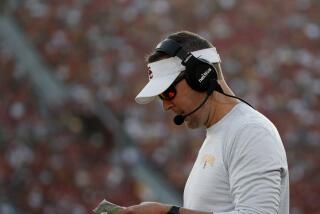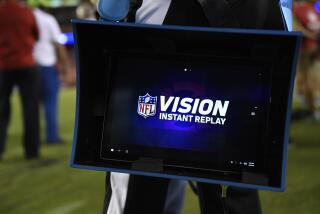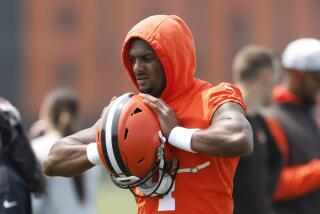Football helmet design can alter concussion rate, study finds
- Share via
Super Bowl viewers might want to keep an eye on the helmets crashing together in Sunday’s game between the Seattle Seahawks and Denver Broncos. A new study says that the lids worn by opposing quarterbacks Peyton Manning and Russell Wilson, not to mention the dreadlock-filled helmet of Seattle cornerback Richard Sherman, can reduce concussion risk by more than half, compared with an older model.
The study adds to a growing consensus that helmet design can impact impacts. This one, published Friday in the Journal of Neurosurgery, was the first to control for the number of impacts different players receive. It measured head motion changes during more than 1.2 million impacts over five years of Division I NCAA football games played by eight college teams.
Sixty-four of those hits resulted in diagnosed concussions, and the relative risk of being among those dizzy denizens of the gridiron was cut by roughly 54% if players wore a more advanced model helmet. Both helmets in the comparison were made by the same manufacturer, Riddell, which is the official helmet of the NFL (at least until Sunday’s game is over and its contract ends).
“If players had matched impacts throughout their whole career, you’d see about half the number of concussions” in the newer helmet, said the study’s lead author, Steven Rowson, a biomedical engineer at the Virginia Tech-Wake Forest University School of Biomedical Engineering and Sciences.
The concussion rate for the more modern helmet worn by both teams’ quarterbacks was slightly less than four per 100,000 hits, compared with a bit more than eight with the older helmet over the same number of impacts, the study found.
The NFL recently agreed to a $764-million settlement that would cover thousands of former players who suffered concussions, some of whom later were diagnosed with serious degenerative brain diseases.
Several previous studies had suggested that helmets with more padding and other design changes could reduce sudden motion changes of the head, which can cause the brain to bump against the skull, and has been correlated with a higher risk of concussion. None had controlled for the number of times each helmet was hit.
“So you don’t necessarily know if you’re comparing a player who is impacted infrequently in one helmet type, versus one player who is not impacted as much,” said Rowson. “You might have a linebacker being compared to a kicker.”
Quarterbacks had the highest recorded head accelerations, followed by running backs and wide receivers, defensive backs, linebackers and linemen on both sides of the ball, according to the study.
Virginia Tech had been placing instruments in the helmets of its football players since 2003, said Rowson. But other teams likewise were doing similar investigations, and they eventually agreed to pool their data.
“There were a lot of different research questions that each group was asking independently,” Rowson said. Virginia Tech, in fact, was not aiming to do a product comparison.
“The point of the study wasn’t necessarily to compare those two specific helmets, but to address the general question of whether or not helmet design plays a role in reducing incidence of concussion.” The automotive industry is keenly interested in such data, he added.
“It’s really hard to study a brain injury in a living human. You can’t take someone in a lab, hit him in the head and see what the clinical outcome is for a certain impact. But the football players, they hit their heads every day voluntarily. So the idea of the research is to instrument that population and observe it over time so you can collect data in a natural and ethical manner.”
Over the five years, about 3% of players sustained concussions, according to the study. A far lower percentage of players in Riddell’s newer Revolution model line sustained concussions than those in the now discontinued VSR4 design.
A spokeswoman for Riddell said the information in the study “continues to show the value of more advanced helmet technology.”
The VSR4 was discontinued in 2011, and the Revolution line was introduced in 2002, according to Riddell. Manning was among the first to adopt the new helmet, versions of which now cover the heads of Wilson and Sherman, according to Riddell spokeswoman Erin E. Griffin.
NFL players can wear the helmet of their choice, but Riddell has been the only manufacturer allowed to display its name on them, under an exclusive contract granted in 1989. The NFL has ended that relationship after this season.
Teams involved in the study included Virginia Tech, University of North Carolina, University of Oklahoma, Dartmouth College, Brown University, University of Minnesota, Indiana University and the University of Illinois.







